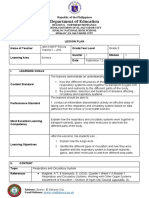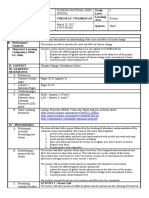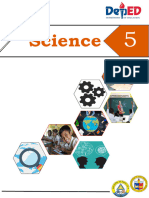SCIENCE 6 4TH QUARTER-changes On The Earth's Surface Alternative Cot 2021-2022
SCIENCE 6 4TH QUARTER-changes On The Earth's Surface Alternative Cot 2021-2022
Uploaded by
Rubyc GarciaCopyright:
Available Formats
SCIENCE 6 4TH QUARTER-changes On The Earth's Surface Alternative Cot 2021-2022
SCIENCE 6 4TH QUARTER-changes On The Earth's Surface Alternative Cot 2021-2022
Uploaded by
Rubyc GarciaOriginal Title
Copyright
Available Formats
Share this document
Did you find this document useful?
Is this content inappropriate?
Copyright:
Available Formats
SCIENCE 6 4TH QUARTER-changes On The Earth's Surface Alternative Cot 2021-2022
SCIENCE 6 4TH QUARTER-changes On The Earth's Surface Alternative Cot 2021-2022
Uploaded by
Rubyc GarciaCopyright:
Available Formats
Republic of the Philippines
Department of Education
REGION X
SCHOOLS DIVISION OF MISAMIS OCCIDENTAL
_________________________________________________________________________________
ALTERNATIVE CLASSROOM OBSERVATION
Detailed Home Learning Plan
School Year 2021 – 2022
Name of Teacher / Master Teacher
School
District
SUBJECT / Grade Level SCIENCE 6
Changes On The Earth’s Surface
TOPIC / SIM Number 1. Describe the changes on the Earth’s surface as a result of
earthquakes and volcanic eruptions. (S6ES-IVa-1)
Date of Learning Delivery
Earthquake is the shaking of the surface of the Earth resulting from a
Science Concept sudden release of energy in the Earth’s lithosphere that creates seismic
waves. And a volcano is a mountain with openings in Earth’s crust.
Science Processes Identifying, Analyzing, Describing, Explaining
Value Infusion Teamwork and Cooperation
Integration
Solar System – Science 6 quarter 3 sim 8
within Learning Area
Interdisciplinary Content
ART, English – role playing
(across Learning Area)
LEARNING TASKS
Specify the point of utilization/implementation of INDICATORS 1, 2, 3, 4 & 5 in the SLM/SIM USED.
TASKS
Learning Material/s Utilized
Details (Expected Learner’s Activity)
Indicator 4 Establish safe and secure learning environments to enhance learning through
the consistent implementation of policies, guidelines and procedures.
Good morning class, before we’ll start our lesson proper, let us always keep in mind to follow the
required health protocols as you enter our school and our classroom. Don’t forget to do the
following:
Write your name on the logbook using your own ballpen.
Wash your hands thoroughly using soap and running water. Apply alcohol afterwards.
Take your temperature and indicate it in the health declaration form.
Follow the signage. Should your temperature be higher than 37.0 degrees, proceed to
the isolation area and take a rest for a while. Then take your body temperature again.
Always wear your mask and maintain social distancing.
Indicator 1: Integration within the learning area
Indicator 2 Display proficient use of Mother Tongue, Filipino and English to facilitate
teaching and learning (Unlocking of difficulties) PowerPoint, worksheets, Tarpapel,
I. Elicit (Review of the previous lesson): SIM
Teacher will show pictures to the pupils. The pupils are then asked to reveal the hidden terms
through crashing the aliens. The aliens are letter x, y and z. The terms that will be revealed were
the terms from the previous lesson.
a. Xyexxayrzzth (Earth --- mao kini ang atong kalibutan)
b. rxyozzcxyksz (rocks --- mga bato)
c. xxpyxylaxynzxetzxys (planets --- mga planeta)
d. xxozrygaxyznyizszzmz (organisms --- mga organism o mga binuhat na nay kinabuhi)
II. Engage:
The class will be divided into 3 groups.
Indicator 4 Establish safe and secure learning environments to enhance learning through
the consistent implementation of policies, guidelines and procedures.
CO through LAC 1|6
Republic of the Philippines
Department of Education
REGION X
SCHOOLS DIVISION OF MISAMIS OCCIDENTAL
_________________________________________________________________________________
Indicator 5 Maintain learning environments that promote fairness, respect and care to
encourage learning
Indicator 6 Maintain learning environments that nurture and inspire learners to
participate, cooperate and collaborate in continued learning.
During group activity, everyone should follow GROUPS
G – give thoughtful feedback
R – respect others and their thoughts
O – on task all the time
U – use soft voices. No shouting please
P – participate actively
S – stay within your group
Indicator 3 Use effective verbal and non-verbal classroom communication strategies to
support learner understanding, participation, engagement and achievement.
Should you have any questions regarding your activity, please raise your hand.
Activity: Modeling Plates
After performing the activity, the pupils will be able to:
1. Determine where earthquake usually occurs.
2. Explain how earthquake occurs.
3. Describe the changes on the Earth’s surface as a result of earthquakes.
Each group will have the following materials:
Large basin with water o palangganang dako na adunay tubig sulod
2 waterproof cards as plates o duha ka-baraha
Procedure:
Group 1:
1. Before testing the plate movements, describe what you think will happen when you pull
the plates (waterproof cards) apart.
2. Very slowly, push down and gently slide the two plates apart.
3. Record what happened on your worksheet.
Group 2:
1. Before testing the plate movements, describe what you think will happen when you push
one plate under the other.
2. Very slowly, push one plate down and under the other plate.
3. Record what happened on your worksheet.
Group 3:
1. Leave a small space between the plates.
2. Push down on the plates so a bit of magma comes up between.
3. Put a few small pebbles on the magma in between the plates.
4. Describe what you think will happen when you slide the plates in opposite directions
alongside each other.
5. Gently slide the plates in opposite directions alongside each other.
6. Record what happened on your worksheet.
Questions:
1. What happened to the waterproof cards as you move them?
Indicator 3 Use effective verbal and non-verbal classroom communication strategies to
support learner understanding, participation, engagement and achievement.
The teacher will call one representative from each group to share the group’s answer to the
question in the activity. Encourage them to give “isang bagsak” to each representative that
participated in the activity.
After all the groups have shared their answer, the teacher will do the processing of the activity.
III. Explore (Group Activity):
Indicator 4 Establish safe and secure learning environments to enhance learning through
the consistent implementation of policies, guidelines and procedures.
Indicator 5 Maintain learning environments that promote fairness, respect and care to
encourage learning
CO through LAC 2|6
Republic of the Philippines
Department of Education
REGION X
SCHOOLS DIVISION OF MISAMIS OCCIDENTAL
_________________________________________________________________________________
Indicator 6 Maintain learning environments that nurture and inspire learners to
participate, cooperate and collaborate in continued learning.
During group activity, everyone should follow GROUPS
G – give thoughtful feedback
R – respect others and their thoughts
O – on task all the time
U – use soft voices. No shouting please
P – participate actively
S – stay within your group
Activity: Lemon Volcanoes!
After performing the activity, the pupils will be able to:
1. Explain how volcanic eruption occurs.
Materials:
Lemon
Lemon juice (from 1 or 2 other lemons)
Baking soda
Popsicle stick
Tray or dish
Food coloring
Dish soap
Procedure:
1. Prepare the lemon by rolling it on the counter. This will help loosen the juice inside.
2. Have an adult cut off the bottom of the lemon to make it flat. This is so the lemon will
stand up without flopping over or rolling away. Try not to cut into the flesh of the lemon or you
may end up with a leaky volcano.
3. The adult will then cut into the top of the lemon to make a hole. This is now your
volcano.
4. Place your lemon volcano onto your tray. Use the popsicle stick to squish and squash
the lemon pulp to release the juice. Scrape the sides along the inside of the lemon, but try not to
puncture the bottom.
5. Squeeze a few drops of dish soap into your volcano. This isn’t necessary but will make
your volcano bubbly.
6. Add a few drops of food coloring to your volcano. This isn’t necessary either, but adds a
little extra pizzazz to the experiment.
7. Add a teaspoon of baking soda to the lemon to activate your volcano. Watch it foam up
and come to life!
8. Use your popsicle stick to mix the lemon juice up a little more. Sprinkle in more baking
soda once your volcano slows down.
9. Add in the extra lemon juice to reactivate your volcano after it settles down again. Have
fun experimenting with the lemon juice and baking soda, adding a little at a time.
Question:
1. How is you’re activity related to volcanic eruption?
2. What have you noticed after the volcano erupted?
3. How do you think will it affect the earth’s surface?
IV. Explain
Indicator 3 Use effective verbal and non-verbal classroom communication strategies to
support learner understanding, participation, engagement and achievement.
The teacher will call one representative from each group to share the group’s answer to the
question in the activity. Encourage them to give “isang bagsak” to each representative that
participated in the activity.
After all the groups have shared their answer, the teacher will give follow up discussion about
volcanic eruption and the changes on the earth’s surface after the eruption.
V. Elaborate (Generalization)
The teacher will give an additional input about the subject matter.
Indicator 3 Use effective verbal and non-verbal classroom communication strategies to
support learner understanding, participation, engagement and achievement.
Next, answer Activity 2 in a ¼ sheet of paper. Don’t hesitate to raise your hand if you have
CO through LAC 3|6
Republic of the Philippines
Department of Education
REGION X
SCHOOLS DIVISION OF MISAMIS OCCIDENTAL
_________________________________________________________________________________
questions regarding the activity.
VI. Evaluate (Role Playing)
Indicator 1: Integration across the learning area (interdisciplinary action)
Indicator 5 Maintain learning environments that promote fairness, respect and care to
encourage learning
Indicator 6 Maintain learning environments that nurture and inspire learners to
participate, cooperate and collaborate in continued learning.
Indicator 8 Design, adapt and implement teaching strategies that are responsive to
learners with disabilities, giftedness and talents
With the same group, each group will show different scenarios:
Group 1: Before and after earthquake happens.
Group 2: Before and after volcanic eruption happens.
Group 3: Easy Volcano Hat (for slow learners)
CO through LAC 4|6
Republic of the Philippines
Department of Education
REGION X
SCHOOLS DIVISION OF MISAMIS OCCIDENTAL
_________________________________________________________________________________
Materials:
Paper plate
Brown paint or brown colored paper
Red and yellow colored paper
Scissors
Glue
1. Take your paper plate and cut straight up the middle, stopping at the center of the
plate. Then cut a 1 inch circle out of the center. Fold one edge of the plate over the
other, forming it into a wide cone. Place some glue along the edge, and glue it down to
secure.
2. Now take your scissors and trim off the excess plate from the inside, and gently push
the cone into a nice round shape.
3. Then twist a couple inches of one end of the strips together. Trim the loose ends of the
strips at different lengths. Then put the twisted end into the top of the volcano, so just
the loose ends are coming out. Flip it over to see the inside.
4. Place a line of glue down the inside, and glue down the twisted end. Flip it back over,
and you’ll see the tissue paper lava coming out of the top of the volcano!
5. And you’re all done!! You can even set a few pieces of extra red tissue paper around the
base to look like a lava pool.
Rubrics:
Content/Relevance- 50 pts.
Discipline- 25 pts.
Teamwork - 25 pts
Total - 20 pts.
VII. Extend
CO through LAC 5|6
Republic of the Philippines
Department of Education
REGION X
SCHOOLS DIVISION OF MISAMIS OCCIDENTAL
_________________________________________________________________________________
Indicator 9 Adapt and use culturally appropriate teaching strategies to address the needs
of learners from indigenous groups
Assignment:
Our municipality is very rich in Subanen culture. Ask your Subanen family members or friends
about the Subanen term of the following:
1. Volcano
2. Earthquake
3. Land
NOTE: Use additional sheets if necessary)
NOTES:
1. Distribute a copy of this Detailed Home Learning Plan LEARNING TASKS to the learner.
2. Attached this to the SLM/LAS utilized for this lesson.
CO through LAC 6|6
You might also like
- Science 6 Q4 Module 1Document17 pagesScience 6 Q4 Module 1Portia Dulce Patatag ToqueroNo ratings yet
- St. James School of Subic, Inc.: in This Unit, The Standards AreDocument8 pagesSt. James School of Subic, Inc.: in This Unit, The Standards AreMel VillafloresNo ratings yet
- COT 2 LP-science3-Q4Document9 pagesCOT 2 LP-science3-Q4Ma Vicenta DelatorreNo ratings yet
- Miranda, Marlibeth 4as CantilanDocument6 pagesMiranda, Marlibeth 4as CantilanMarso TreseNo ratings yet
- 2nd - COT - Science 7 - LESSON PLAN (Q4) - 2021-2022Document6 pages2nd - COT - Science 7 - LESSON PLAN (Q4) - 2021-2022Malixi Integrated School (CARAGA - Surigao del Sur)No ratings yet
- COT PLAN 1st - AndrinoDocument5 pagesCOT PLAN 1st - AndrinojullienneNo ratings yet
- Science 5-Q4-SLM1Document15 pagesScience 5-Q4-SLM1Rosario FuertezNo ratings yet
- Science 6 Q4 SLM2Document14 pagesScience 6 Q4 SLM2Maria Leira Calubayan- LaurelNo ratings yet
- Earth - Life 11 - Q1 - M5Document14 pagesEarth - Life 11 - Q1 - M5Patrick BolinboughNo ratings yet
- Earth Science11 Q1 MOD4 Classification of Rocks 08082020 1 1Document17 pagesEarth Science11 Q1 MOD4 Classification of Rocks 08082020 1 1Eishan Jef RifamonteNo ratings yet
- Earth and Life Science: Formation of Rock LayersDocument32 pagesEarth and Life Science: Formation of Rock Layershara azur100% (2)
- Cot2 Lontoc-Seasons in The PhilippinesDocument6 pagesCot2 Lontoc-Seasons in The PhilippinesMHadzNo ratings yet
- 3rd QTR CotDocument8 pages3rd QTR Cotsofia gamer girlNo ratings yet
- PE9 Q4 M6 L6 - MergedDocument91 pagesPE9 Q4 M6 L6 - MergedBPISHERENo ratings yet
- Earth - Life 11 - Q1 - M1Document15 pagesEarth - Life 11 - Q1 - M1Patrick BolinboughNo ratings yet
- Science 6-Q4-SLM5Document14 pagesScience 6-Q4-SLM5MARIA CECILIA DAGAMINo ratings yet
- Department of Education: Republic of The PhilippinesDocument7 pagesDepartment of Education: Republic of The PhilippinesRachelle CauseNo ratings yet
- Earth Science 11 Q2 M1Document15 pagesEarth Science 11 Q2 M1Aizen LianNo ratings yet
- English 7 Q4 M8Document16 pagesEnglish 7 Q4 M8Trazhell CruzNo ratings yet
- 1st ScienceDocument6 pages1st ScienceJoan Ibay-AntolinNo ratings yet
- Earth and Life Science: Geologic Time Scale: Relative and Absolute DatingDocument24 pagesEarth and Life Science: Geologic Time Scale: Relative and Absolute Datinghara azurNo ratings yet
- Daily Lesson Plan Co Q1Document7 pagesDaily Lesson Plan Co Q1Annabele GamayonNo ratings yet
- Lesson Plan - Week 2 Science 9Document4 pagesLesson Plan - Week 2 Science 9JAEN KIETH ROCIOSNo ratings yet
- Earth and Life Science: Quarter 1 - Module 14: Geologic TimelineDocument26 pagesEarth and Life Science: Quarter 1 - Module 14: Geologic Timelinehara azurNo ratings yet
- SLM Envi Sci Q2 Week 2Document23 pagesSLM Envi Sci Q2 Week 2demaangaylNo ratings yet
- Department of Education: Republic of The PhilippinesDocument5 pagesDepartment of Education: Republic of The PhilippinesAleixs miraplesNo ratings yet
- English Module 7-Q4 Module 8Document18 pagesEnglish Module 7-Q4 Module 8Michael Ritz Estillore100% (1)
- Earth Science-11-Q1M1.3-S11ES-Ib-5Document27 pagesEarth Science-11-Q1M1.3-S11ES-Ib-5Zhexie ValentineNo ratings yet
- FINAL - EARTH SCIENCE - Q2 - S11ES IIj 39 - LIBUNAO JR. DONATO CHANGCO - SMNHSDocument32 pagesFINAL - EARTH SCIENCE - Q2 - S11ES IIj 39 - LIBUNAO JR. DONATO CHANGCO - SMNHSJoshua Sta AnaNo ratings yet
- Demo Teaching LP Science 9 3rdDocument6 pagesDemo Teaching LP Science 9 3rdJOEVANNIE S. PAGAURA100% (3)
- Science 8 Slm18Document15 pagesScience 8 Slm18Cristian ErfeNo ratings yet
- 7 ELS Final Module 7 08082020Document26 pages7 ELS Final Module 7 08082020Erma AlivioNo ratings yet
- COT PLAN 2nd - AndrinoDocument6 pagesCOT PLAN 2nd - AndrinojullienneNo ratings yet
- Science 4 - Q1 - M3Document15 pagesScience 4 - Q1 - M3Marilou Sacristia-RazalanNo ratings yet
- AMPOL COT 2 LP Practical Research 2Document6 pagesAMPOL COT 2 LP Practical Research 2Argie Joy Marie AmpolNo ratings yet
- Department of Education: Practical Research 1Document5 pagesDepartment of Education: Practical Research 1Patrocinio Jr GamboaNo ratings yet
- English 7-Q3-M10Document14 pagesEnglish 7-Q3-M10Joams artsNo ratings yet
- General Biology 2: Quarter 3 - Module 2: History of Life On Earth & Mechanisms of EvolutionDocument45 pagesGeneral Biology 2: Quarter 3 - Module 2: History of Life On Earth & Mechanisms of EvolutionCzarina Nicole DamoNo ratings yet
- Grade-8-Science-2nd-Quarter-DLP WITH INDICATORDocument5 pagesGrade-8-Science-2nd-Quarter-DLP WITH INDICATORMontealegre Nhet100% (4)
- Science 1sth QTR CotDocument4 pagesScience 1sth QTR Cotsofia gamer girl100% (1)
- Contextualized LP in General MathematicsDocument6 pagesContextualized LP in General MathematicsSerdnelem Rhodz MacedaNo ratings yet
- Sept 10,2024Document3 pagesSept 10,2024Noresa Dacula Engcong - AbasNo ratings yet
- G10-MATHEMATICS-DLL-Q3-W7-March 13Document12 pagesG10-MATHEMATICS-DLL-Q3-W7-March 13MARK RAYMOND DOMINGONo ratings yet
- SLM Envi Sci Q3 Week 3-4 Part1Document18 pagesSLM Envi Sci Q3 Week 3-4 Part1joelainetoribioNo ratings yet
- Earth and Life Science Q1 M6Document29 pagesEarth and Life Science Q1 M6caolealleahfaithNo ratings yet
- Exemplar Science Lesson Plan in Science 1ST QuarterDocument5 pagesExemplar Science Lesson Plan in Science 1ST Quarterroxanne paconNo ratings yet
- Science 4 q4 Slm1Document14 pagesScience 4 q4 Slm1Daryl Oribiada100% (1)
- English 4 Q4 L2 ModuleDocument14 pagesEnglish 4 Q4 L2 ModuleJohn Rich CaidicNo ratings yet
- Science 5-Q3-SLM7Document14 pagesScience 5-Q3-SLM7jezel.mirambelNo ratings yet
- LP in Natural Resources - 014239Document14 pagesLP in Natural Resources - 014239Christelle AlceraNo ratings yet
- ADM-Physical Science Q2 Module 4Document23 pagesADM-Physical Science Q2 Module 4Hector Panti100% (1)
- Homeroom G.Document7 pagesHomeroom G.maechek7No ratings yet
- LP Probability FDULDULAO Modified-Obj-9 10Document7 pagesLP Probability FDULDULAO Modified-Obj-9 10Florence Reyes DuldulaoNo ratings yet
- Lesson Plan-PopulationDocument15 pagesLesson Plan-PopulationBlezy Guiroy100% (1)
- Week 2Document25 pagesWeek 2joelainetoribioNo ratings yet
- Quarter 1 DLLLesson 1 For SubmissionDocument5 pagesQuarter 1 DLLLesson 1 For SubmissionSujeth G. MangadlaoNo ratings yet
- Arpan6 q4 Mod6 Aralin4 Kahalagahanngpangangalagangkapaligiran v5Document22 pagesArpan6 q4 Mod6 Aralin4 Kahalagahanngpangangalagangkapaligiran v5Lorie AnnNo ratings yet
- Lesson Plan For CO1Document11 pagesLesson Plan For CO1Cristy Falcasantos AranjuezNo ratings yet
- Health Day 2Document3 pagesHealth Day 2ERWIN SALITANo ratings yet
- Department of Education: Monday Tuesday Wednesday Thursday FridayDocument5 pagesDepartment of Education: Monday Tuesday Wednesday Thursday FridayMa Elena ClaroNo ratings yet
- A Semi-Detailed Lesson Plan in Earthquakes and FaultsDocument2 pagesA Semi-Detailed Lesson Plan in Earthquakes and FaultsMarianne Serrano100% (1)
- Planets, Dwarf Planets & MoonsDocument24 pagesPlanets, Dwarf Planets & MoonsSteve HetheringtonNo ratings yet
- Ciclo de WilsonDocument1 pageCiclo de WilsonRGeomathNo ratings yet
- DRRR Module 11 Earthquake Hazards and Risk Reduction Methods Commented 08082020Document29 pagesDRRR Module 11 Earthquake Hazards and Risk Reduction Methods Commented 08082020Ellen CruzNo ratings yet
- Lesson Plan Plate BoundariesDocument3 pagesLesson Plan Plate Boundariesapi-404788538No ratings yet
- Identification Description: Macquarie UniversityDocument6 pagesIdentification Description: Macquarie Universitygendeng jancukNo ratings yet
- SAT 2019 - Practice Test 3Document30 pagesSAT 2019 - Practice Test 3AddieBeamNo ratings yet
- Exit Exam G10.Document6 pagesExit Exam G10.John Keneth Baysac CadeliniaNo ratings yet
- Vanshdeep Singh - Task 1 - SubmissionsDocument4 pagesVanshdeep Singh - Task 1 - Submissionsvanshdeep.singh0987654321No ratings yet
- Pointers To Review Grade 10Document10 pagesPointers To Review Grade 10Jeffrey aragon100% (1)
- SDO Navotas Sci10 Q1 Lumped - FVDocument50 pagesSDO Navotas Sci10 Q1 Lumped - FVjeenamarieonsayortizNo ratings yet
- (Template) As WEEK 5&6Document3 pages(Template) As WEEK 5&6Jaemee Agnes BoadoNo ratings yet
- (Nature (Volume 433 Number 7021 Pp1-90) 433 7021) Philip Campbell. 433-Nature Publishing Group (2005)Document89 pages(Nature (Volume 433 Number 7021 Pp1-90) 433 7021) Philip Campbell. 433-Nature Publishing Group (2005)Siva SubramaniNo ratings yet
- Plate TektonikDocument22 pagesPlate TektonikheniarieantiNo ratings yet
- Regions Inregions in The Philippines The Philippines.Document167 pagesRegions Inregions in The Philippines The Philippines.Julia PaverNo ratings yet
- The Theory of Seafloor SpreadingDocument10 pagesThe Theory of Seafloor SpreadingAnonymous vbSkmwNo ratings yet
- Infosys Test Paper 22Document33 pagesInfosys Test Paper 22Vamshidhar ReddyNo ratings yet
- Plate Tectonics VACATION: You Are Going On A Vacation! Pack Your Bags! No More School!Document3 pagesPlate Tectonics VACATION: You Are Going On A Vacation! Pack Your Bags! No More School!ignatius romeroNo ratings yet
- Characteristics of Earth To Support LifeDocument9 pagesCharacteristics of Earth To Support LifeRosalyn Therese S. RayosNo ratings yet
- Revision Checklist For IGCSE GeographyDocument30 pagesRevision Checklist For IGCSE GeographyKwadwo Kankam100% (6)
- SCIENCE 10 (Week 4)Document9 pagesSCIENCE 10 (Week 4)trishamae pimentelNo ratings yet
- Earth Science Module 9-10Document6 pagesEarth Science Module 9-10Lopez AeraNo ratings yet
- Buku BAHASA INGGRISDocument16 pagesBuku BAHASA INGGRISMusa ArdinataNo ratings yet
- (Template) Earth and Life Science Module2Document10 pages(Template) Earth and Life Science Module2Giem NovenarioNo ratings yet
- Earth Continental Drift Plate Tectonics Sea Floor Spreading-0Document59 pagesEarth Continental Drift Plate Tectonics Sea Floor Spreading-0MALOU ELEVERANo ratings yet
- Mark Scheme (Results) Summer 2019: Pearson Edexcel International GCSE in Pakistan Studies (4PA1) Paper 02Document19 pagesMark Scheme (Results) Summer 2019: Pearson Edexcel International GCSE in Pakistan Studies (4PA1) Paper 02Muhammad SaleemNo ratings yet
- Science 10 - Q1 - DW5Document3 pagesScience 10 - Q1 - DW5Des AbrasiaNo ratings yet
- De HSG Cum-Dot 2 - 2022-2023Document13 pagesDe HSG Cum-Dot 2 - 2022-2023Na LêNo ratings yet
- Types of Disasters - 0Document8 pagesTypes of Disasters - 0William Jaya PrakashNo ratings yet

























































































